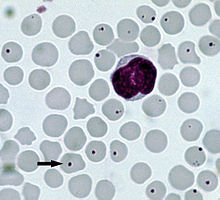| Ehrlichiaceae | |
|---|---|

| |
| The rickettsial bacterium Anaplasma centrale infecting red blood cells of a cow. Arrow points to typical infected cell. | |
| Scientific classification | |
| Domain: | Bacteria |
| Phylum: | Pseudomonadota |
| Class: | Alphaproteobacteria |
| Order: | Rickettsiales |
| Family: | Ehrlichiaceae Moshkovski 1945 (Approved Lists 1980) |
| Genera[4] | |
| |
| Synonyms[5] | |
| |
The Ehrlichiaceae are a family of bacteria, included in the order Rickettsiales.[4]
References[edit]
- ^ Eshoo MW, Carolan HE, Massire C, Chou DM, Crowder CD, Rounds MA, Phillipson CA, Schutzer SE, Ecker DJ (2015). "Survey of Ixodes pacificus Ticks in California Reveals a Diversity of Microorganisms and a Novel and Widespread Anaplasmataceae Species". PLOS ONE. 10 (9): e0135828. Bibcode:2015PLoSO..1035828E. doi:10.1371/journal.pone.0135828. PMC 4574436. PMID 26375033.
- ^ Kawahara M, Rikihisa Y, Isogai E, Takahashi M, Misumi H, Suto C, Shibata S, Zhang C, Tsuji M (2004). "Ultrastructure and phylogenetic analysis of "Candidatus Neoehrlichia mikurensis" in the family Anaplasmataceae, isolated from wild rats and found in Ixodes ovatus ticks". Int J Syst Evol Microbiol. 54 (Pt 5): 1837–1843. doi:10.1099/ijs.0.63260-0. PMID 15388752.
- ^ Kreier JP, Ristic M (1963). "Anaplasmosis. XII. The growth and survival in deer and sheep of the parasites present in the blood of calves infected with the Oregon strain of Anaplasma marginale". Am J Vet Res. 24: 697–702. PMID 14035670.
- ^ a b Euzéby JP, Parte AC. "Ehrlichiaceae". List of Prokaryotic names with Standing in Nomenclature (LPSN). Retrieved June 1, 2021.
- ^ Hördt, Anton; López, Marina García; Meier-Kolthoff, Jan P.; Schleuning, Marcel; Weinhold, Lisa-Maria; Tindall, Brian J.; Gronow, Sabine; Kyrpides, Nikos C.; Woyke, Tanja; Göker, Markus (7 April 2020). "Analysis of 1,000+ Type-Strain Genomes Substantially Improves Taxonomic Classification of Alphaproteobacteria". Frontiers in Microbiology. 11: 468. doi:10.3389/fmicb.2020.00468. PMC 7179689. PMID 32373076.
External links[edit]
- Ehrlichieae at the U.S. National Library of Medicine Medical Subject Headings (MeSH)
Well, that’s interesting to know that Psilotum nudum are known as whisk ferns. Psilotum nudum is the commoner species of the two. While the P. flaccidum is a rare species and is found in the tropical islands. Both the species are usually epiphytic in habit and grow upon tree ferns. These species may also be terrestrial and grow in humus or in the crevices of the rocks.
View the detailed Guide of Psilotum nudum: Detailed Study Of Psilotum Nudum (Whisk Fern), Classification, Anatomy, Reproduction